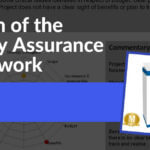In the last post, PMO Quality Assurance part 2 – prioritise projects to review it covered the approach for building an inventory of active projects and then how to prioritise the list in order to focus on the most important projects. Now it is time to create a schedule of the project QA reviews. However, before just starting from the top of the list and working chronologically through the calendar, there are a number of considerations to ensure maximum value and minimum interruption.
PMO QA Scheduling Considerations
1. Project Lifecycle
In order to get maximum benefit you need to time the QA review at a time where there is sufficient progress to perform QA, but not too far progressed so remediation action can be taken to correct weaknesses.
If the QA is conducted too early, many of the questions will come back as N/A (not applicable) or as a failing rating. The project manager will quite rightly state that this is because the project is only starting to mobilise and the sponsor will see the QA as a waste of time and money.
If the QA is conducted too late, there may not be time to make interventions to change the course of the project meaning that the QA is a waste as, while you know there is an issue, there is very little can be done to make corrections.
So, the best approach is to work with the project manager to identify appropriate checkpoints where it will be sensible to conduct the reviews. This is normally as a project moves from one phase of delivery to the next i.e. completion of mobilisation, analysis / design, build, etc.
2. Avoid Critical Points
There will be times for the project team when there will be many other competing priorities for the scarce commodity time. For example, when the project team is working flat out to complete the analysis phase to a hard deadline. The last thing they need is for the PMO trying to conduct a QA review. This will result in effort being diverted to work on the QA review meaning the completion on the analysis phase may be missed. That would not be a good for the career progression of the PMO manager who scheduled the review.
3. PMO Bandwidth
Likewise, there will be busy periods for PMO activity. The PMO should avoid putting themselves under pressure of having to complete multi deliverable’s simultaneously as this usually results in inferior output.
4. Sponsor / Stakeholder Input
It is always worth getting input from the sponsor and / or stakeholders. These are the people ultimately responsible for the successful delivery, providing funding and the most interest in the (successful) results. Therefore, it is only right that they should have input when they would like reviews conducted to give them confidence in the outcomes.
Finally….
Like with most things when it comes to project delivery and the PMO, use common sense as part of the decision process. The next post will cover the mechanics of the QA review.
Quality Assurance Resources
 If you would like to accelerate the implementation of a project quality assurance process, you may be interested in the Quality Assurance Framework by PM Majik.
If you would like to accelerate the implementation of a project quality assurance process, you may be interested in the Quality Assurance Framework by PM Majik.
This framework provides all of the tools, templates and guides to implement a project quality assurance process and executive reporting. The assurance review teamplate comes pre-populated with 120 ready to use review questions!
For more information visit Quality Assurance Framework.






